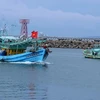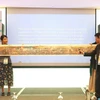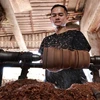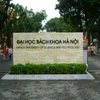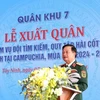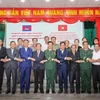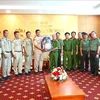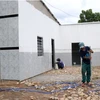The sources of cattle feed will improve with the application of new technology in processing and preserving crop residues in Hanoi's districts.
Two techniques of processing and preserving fresh straw for cattle have been tested at MTV Cattle Breed Co. Ltd since last October and have brought high profits for farmers in Gia Lam and Dong Anh districts, besides reducing environment pollution.
Millions of tonnes of straw are available after crop harvests, which is an abundant source of feed for ruminants in Vietnam, especially during the dry season.
Several methods have been proposed for improving the nutritive value of rice straw, usually by spraying urea on the straw in a tank and then making soft cakes or hard blocks of straw. After about two to three weeks, the cakes can be fed to animals and be preserved for months.
After trials, the company prepared some techniques for cattle breeders. It has had great economic effect.
"Previously, after harvest, farmers often burned the straw in the field. But now it is sold to the company for making animal feed, which farmers can preserve for months," DinhThiHoai Thu, a dairy farmer in Phu Dong Commune, said.
Statistics of Gia Lam District's economic department show the district has about 9,000 cows. Cattle breeding is becoming the main income provider for many farmers in the region.
Fresh straw is harvested from about 40 percent of the rice cultivation area in Gia Lam district and sold to the company. Environment pollution has also reduced significantly, as the farmers are not burning the straw after harvest.
During the trial period, the company purchased and preserved 1,200 tonnes of fresh straw. Thanks to the new technique, the protein level in the straw is higher than in non-processed straw.
Hanoi now has more than 140,000 buffaloes and cows, more than 15,000 of which are dairy cattle. Consequently, the demand for animal feed is very large, especially in winter. Meanwhile, in many areas, farmers still lack feed sources due to limited grassland areas.
The development of this technique to process and preserve feed for cattle is very important to farmers.
Nguyen Van Tuan, deputy head of the economic department of Gia Lam District, has suggested the city should direct the department of agriculture and rural development and related agencies to expand this processing model among locals, particularly in specialised cattle-breeding and rice-growing areas.
Gia Lam District alone has 5,500ha of rice fields and the annual harvest produces around 30,000 tonnes of straw. "Just 1ha of rice field will produce six to seven tonnes of straw, and it will be enough to feed a beef cow for one year," Tuan said.
Vu Van Hai, deputy director of the MTV Cattle Breed Co. Ltd, said the application of this new technology would help preserve fresh straw, without the development of mould and loss of organic matter, and would increase its digestibility and allow cows to eat more. Therefore, this new model can be applied by farmers and the cattle-breeding farms across the country. Cattle productivity will also improve to meet the daily demand for meat and dairy products.-VNA
Two techniques of processing and preserving fresh straw for cattle have been tested at MTV Cattle Breed Co. Ltd since last October and have brought high profits for farmers in Gia Lam and Dong Anh districts, besides reducing environment pollution.
Millions of tonnes of straw are available after crop harvests, which is an abundant source of feed for ruminants in Vietnam, especially during the dry season.
Several methods have been proposed for improving the nutritive value of rice straw, usually by spraying urea on the straw in a tank and then making soft cakes or hard blocks of straw. After about two to three weeks, the cakes can be fed to animals and be preserved for months.
After trials, the company prepared some techniques for cattle breeders. It has had great economic effect.
"Previously, after harvest, farmers often burned the straw in the field. But now it is sold to the company for making animal feed, which farmers can preserve for months," DinhThiHoai Thu, a dairy farmer in Phu Dong Commune, said.
Statistics of Gia Lam District's economic department show the district has about 9,000 cows. Cattle breeding is becoming the main income provider for many farmers in the region.
Fresh straw is harvested from about 40 percent of the rice cultivation area in Gia Lam district and sold to the company. Environment pollution has also reduced significantly, as the farmers are not burning the straw after harvest.
During the trial period, the company purchased and preserved 1,200 tonnes of fresh straw. Thanks to the new technique, the protein level in the straw is higher than in non-processed straw.
Hanoi now has more than 140,000 buffaloes and cows, more than 15,000 of which are dairy cattle. Consequently, the demand for animal feed is very large, especially in winter. Meanwhile, in many areas, farmers still lack feed sources due to limited grassland areas.
The development of this technique to process and preserve feed for cattle is very important to farmers.
Nguyen Van Tuan, deputy head of the economic department of Gia Lam District, has suggested the city should direct the department of agriculture and rural development and related agencies to expand this processing model among locals, particularly in specialised cattle-breeding and rice-growing areas.
Gia Lam District alone has 5,500ha of rice fields and the annual harvest produces around 30,000 tonnes of straw. "Just 1ha of rice field will produce six to seven tonnes of straw, and it will be enough to feed a beef cow for one year," Tuan said.
Vu Van Hai, deputy director of the MTV Cattle Breed Co. Ltd, said the application of this new technology would help preserve fresh straw, without the development of mould and loss of organic matter, and would increase its digestibility and allow cows to eat more. Therefore, this new model can be applied by farmers and the cattle-breeding farms across the country. Cattle productivity will also improve to meet the daily demand for meat and dairy products.-VNA

